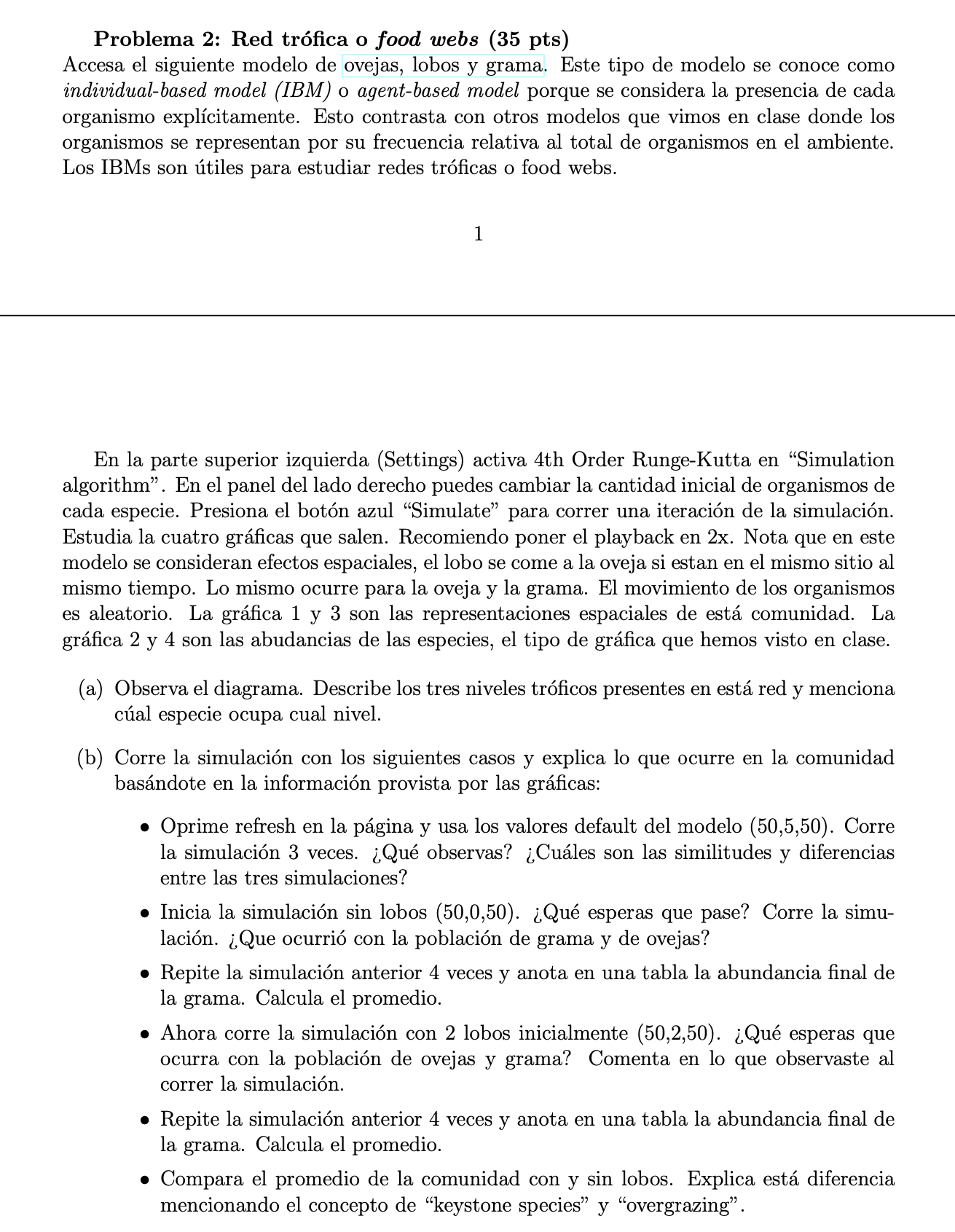Pregunta: Access the following model of sheep, wolves and grass. This type of model is known as individual-based model (IBM) or agent-based model because the presence of each organism is considered explicitly. This contrasts with other models we saw in class where organisms are represented by their frequency relative to the total number of organisms in the
Access the following model of sheep, wolves and grass. This type of model is known as individualbased model IBM or agentbased model because the presence of each organism is considered explicitly. This contrasts with other models we saw in class where organisms are represented by their frequency relative to the total number of organisms in the environment.IBMs are useful for studying food webs or food webs.In the top left Settings activate th Order RungeKutta in "Simulation algorithm". In the right side panel you can change the initial number of organisms of each species. Press the blue "Simulate" button to run an iteration of the simulation.Study the four graphs that appear. I recommend setting the playback to x Note that in this model spatial effects are considered, the wolf eats the sheep if they are in the same place at the same time. The same thing happens for the sheep and the grass. The movement of organisms is random. Graph and are the spatial representations of this community. Graphs and are the abundances of the species, the type of graph we have seen in class.a Look at the diagram. Describe the three trophic levels present in this network and mentionWhich species occupies which level.b Run the simulation with the following cases and explain what happens in the communitybased on the information provided by the graphs:Press refresh on the page and use the model's default values Run the simulation times. What do you observe? What are the similarities and differences between the three simulations?Start the simulation without wolves What do you expect to happen? Run the simulation. What happened to the grass and sheep population?Repeat the previous simulation times and record the final abundance of the grass in a table. Calculate the average.Now run the simulation with wolves initially What do you expect to happen to the sheep and grass population? Comment on what you observedrun the simulation.Repeat the previous simulation times and record the final abundance of the grass in a table. Calculate the average.Compare the community average with and without wolves. Explain this difference by mentioning the concept of "keystone species" and "overgrazing".Problema : Red trfica o food webs ptsAccesa el siguiente modelo de ovejas, lobos y grama. Este tipo de modelo se conoce comoindividualbased model IBM o agentbased model porque se considera la presencia de cadaorganismo explcitamente Esto contrasta con otros modelos que vimos en clase donde losorganismos se representan por su frecuencia relativa al total de organismos en el ambiente.Los IBMs son tiles para estudiar redes trficas o food webs.En la parte superior izquierda Settings activa th Order RungeKutta en "Simulationalgorithm". En el panel del lado derecho puedes cambiar la cantidad inicial de organismos decada especie. Presiona el botn azul "Simulate" para correr una iteracin de la simulacinEstudia la cuatro grficas que salen. Recomiendo poner el playback en Nota que en estemodelo se consideran efectos espaciales, el lobo se come a la oveja si estan en el mismo sitio almismo tiempo. Lo mismo ocurre para la oveja y la grama. El movimiento de los organismoses aleatorio. La grfica y son las representaciones espaciales de est comunidad. Lagrfica y son las abudancias de las especies, el tipo de grfica que hemos visto en clase.a Observa el diagrama. Describe los tres niveles trficos presentes en est red y mencionacal especie ocupa cual nivel.b Corre la simulacin con los siguientes casos y explica lo que ocurre en la comunidadbasndote en la informacin provista por las grficas:Oprime refresh en la pgina y usa los valores default del modelo Correla simulacin veces. Qu observas? Cules son las similitudes y diferenciasentre las tres simulaciones?Inicia la simulacin sin lobos Qu esperas que pase? Corre la simulacinQue ocurri con la poblacin de grama y de ovejas?Repite la simulacin anterior veces y anota en una tabla la abundancia final dela grama. Calcula el promedio.Ahora corre la simulacin con lobos inicialmente Qu esperas queocurra con la poblacin de ovejas y grama? Comenta en lo que observaste alcorrer la simulacinRepite la simulacin anterior veces y anota en una tabla la abundancia final dela grama. Calcula el promedio.Compara el promedio de la comunidad con y sin lobos. Explica est diferenciamencionando el concepto de "keystone species" y "overgrazing".
- Esta pregunta aún no se resolvió!¿No es lo que buscas?Envía tu pregunta a un experto en la materia.

Estudia mejor, ¡ahora en español!
Entiende todos los problemas con explicaciones al instante y pasos fáciles de aprender de la mano de expertos reales.